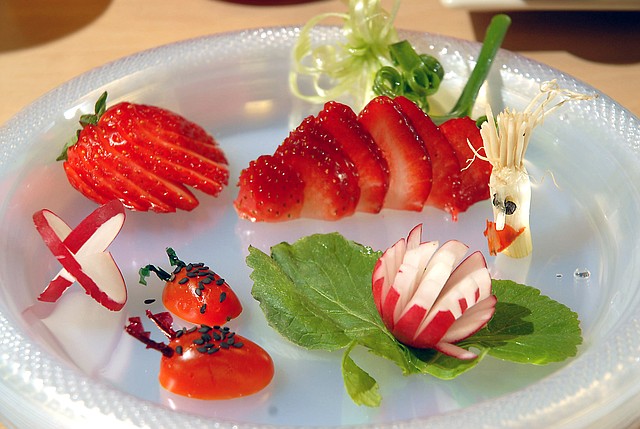Class has right ingredients for fun, learning
Wednesday, February 24, 2010
Reading, writing and arithmetic are staples of a good education. For some seventh-grade students at Center for Creative Arts, cucumbers, scallions and cherry tomatoes are too.
Students needing help in math have been attending a program called Culinary Math that shows how cooking and arithmetic are two ingredients that blend together well for learning.
"It scares some students to think about math class," said Melanie Biederman, the school's instructional coach. "So this is a fun way to engage them with math curriculum."
Ms. Biederman, who came up with the idea for Culinary Math, was awarded a grant from the Junior League of Chattanooga's Mini Grants in Action program to make it happen.
The first session, held in December, was a candy-making class to learn about ratios and proportions. Students determined the ratio of an ingredient to the recipe and proportionately adapted the remaining ingredients to feed from two to 100 people.
"By multiplying and dividing fractions, students adjusted recipe ingredient amounts making real-world applications to math concepts," Ms. Biederman said.
This month's lesson was all about garnishes, with students learning how to make the clever decorations, then using their math skills to draw them to scale. The session, led by chef Nick Goeller of 212 Market, taught the students how to make flowers from scallions, ladybugs from cherry tomatoes and palm trees from cucumbers.
The garnish class was not only fun for the students but was intended to held them with measurements. After watching Mr. Goeller make the garnishes, the students made some for themselves.
"So far, they love the idea," Ms. Biederman said.
"I knew this was going to be challenging," said 12-year-old Alexis Carroll as she concentrated on cutting a strawberry fan. "But I didn't think it would be this fun."
"And we get to eat the food," said Austin Burgin, 13.
The classes are serving their true purpose too, according to the students.
"The last test I took, I usually would have failed, but I passed," Austin said. "I like learning about the food, too. I didn't even know what a garnish was."
The Junior League of Chattanooga annually awards Mini Grants to Hamilton County teachers who strive to engage students in innovative ways.
"We are thrilled that we can grant funds to fuel teachers' creativity to hook young learners with creative and enriching projects," said Junior League president Missy McKenna.
Final class sessions will include a service learning project with a local gardener to plant vegetables to determine crop yield as well as a culminating dinner party catered by the students.
KITCHEN ARITHMETIC
Try finding at least one time each week that your children can help you prepare a meal from start to finish. Not only is this good bonding time, it teaches responsibility and provides simple ways to enhance children's math skills.
* Ask them to measure your pans when a recipe calls for a certain size pan.
* Ask them to read recipes to you and let you know how much you need of each ingredient.
* Ask them to cut food items into a certain number of pieces.
* Teach them to use measuring spoons and cups.
* Teach them to set the oven to certain degrees.
* Teach them to watch the time and alert you when a dish should be ready.
Source: www.associatedcontent.com
ADD A GARNISH
Garnishes add the finishing touch to any plate. Here are some examples from recipes.howstuffworks.com:
Green onion curls: Cut off roots with a paring knife. Cut a 3-inch piece from each stalk, leaving about 1 1/2 inches of both the white and green portions. Make lengthwise cuts in the green portion, repeating to slice the green end into thin slivers. Place onion in cold water, and let stand 30 seconds or until ends curl slightly. Drain well, and store refrigerated in an airtight container until needed.
Radish fans: Trim ends with a sharp paring knife, then cut 1/8-inch-thick slices, being careful not to cut all the way through. Place in ice water and refrigerate several hours until radishes fan out. Drain well before using. Add a sprig of parsley for contrast, if desired.
Tomato roses: Core the tomato, then cut a thin slice off the bottom. Starting at the top, peel the tomato skin off in a continuous strip with a paring knife, using a gentle sawing motion. To form the "rose," roll the strip into a coil, and tuck the end under the "rose" to secure it. Add parsley or leaves of any other green herb for a finishing touch.
Fluted mushrooms: Clean and dry mushrooms; remove the stems. Hold the paring knife at a 45-degree angle and cut a 1/8-inch-thick groove from the top of the mushroom to the edge of the cap, making six to eight cuts. With the knife tip, remove the cutouts, then dip the mushrooms into lemon juice to keep them from browning. Add parsley or other green herb leaves, if you prefer.
Strawberry fans: Choose strawberries with intact stems. With a paring knife, make four or five lengthwise cuts, almost to the stem end. Fan slices apart, being careful to keep the stem end intact.
Chocolate cutouts: Use 1 teaspoon of shortening for every 2 ounces of chocolate. Melt the mixture in a double boiler (be careful not to get any water into the chocolate). Pour the melted chocolate onto a baking sheet lined with wax paper. Cool until the chocolate is firm (don't chill in the refrigerator). Cut the chocolate into various shapes with hors d'oeuvre or cookie cutters. Loosen the chocolate from the wax paper with a metal spatula. Store in a cool, dry place until ready to use.

